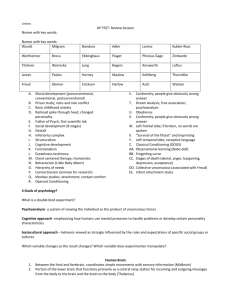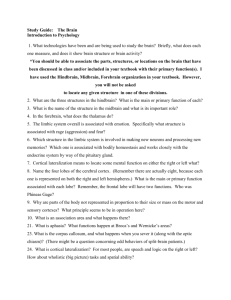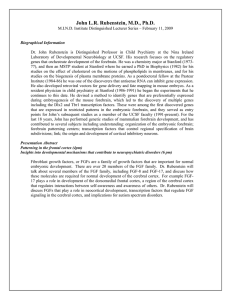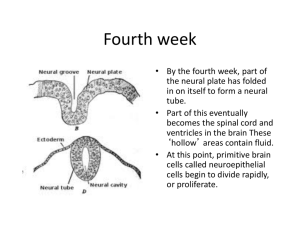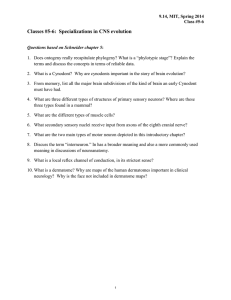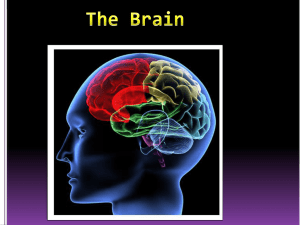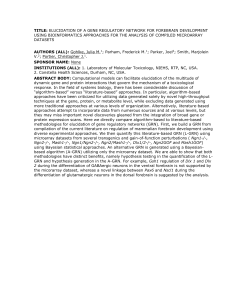Lecture #30 Key concepts in learning: 9.20
advertisement
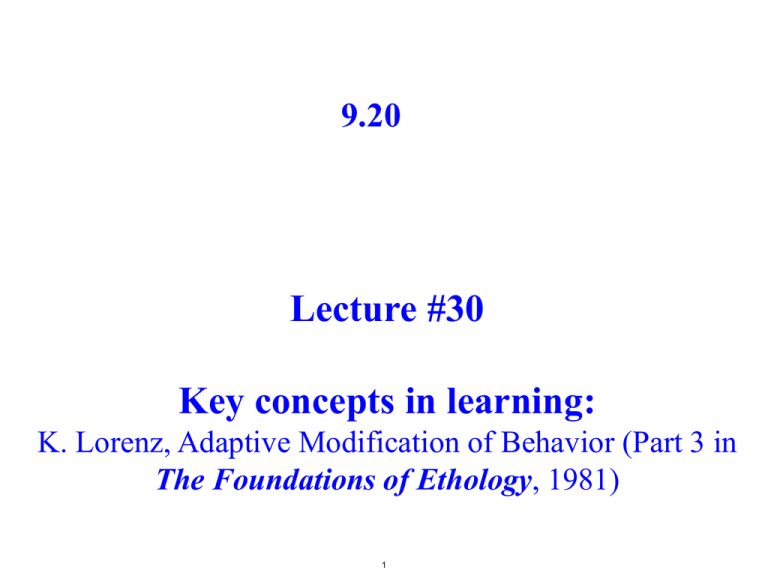
9.20 Lecture #30 Key concepts in learning: K. Lorenz, Adaptive Modification of Behavior (Part 3 in The Foundations of Ethology, 1981) 1 Comments about the various types of learning: • Species differences? • Brain localization? We can make educated guesses, in some cases supported by experiments. • (General rules? Different for different types.) 2 Major types of learning (K. Lorenz) Learning without association • • Wide range of species, including invertebrates Sensory & motor pathways, lower brainstem integrating mechanisms including cerebellum Learning through association without feedback reporting success (Widespread in vertebrates; less studied in invertebrates) 1. Habituation linked with association (environment) – Mostly forebrain, both non-spatial and spatial learning 2. Becoming accustomed (IRM becomes more selective) − Forebrain influences on midbrain mechanisms are suggested. 3. Conditioned reflex (habit formation by stimulus selection) – Pavlov focused on neocortex but experimenters have found conditioning even in spinal animals. 3 Major types of learning (K. Lorenz) Learning without association Learning through association without feedback reporting success 1. 2. 3. Habituation linked with association (environment) Becoming accustomed (IRM becomes more selective) Conditioned reflex (habit formation by stimulus selection) 4. Avoidance response learned thru trauma » 5. 6. Striatal mechanisms involved, together with perceptual apparatus of forebrain Imprinting: midbrain as well as forebrain Conditioned inhibition: Forebrain, especially striatal mechanisms 4 Learning effected by the consequences of behavior – Striatal habit learning Motor learning – – Cerebellar mechanisms of hindbrain Prefrontal and premotor cortical areas Exploratory behavior or curiosity – Most developed in higher vertebrates, especially in those with large neocortex or hyperpallium (Wulst) in birds 5 Classification of learning mechanisms in neuroscience 1. Focus on forebrain pathways and their evolution 2. Focus on synaptic mechanisms 3. Focus on anatomical changes • The following is based only on the first focus 6 Categories of major types of learning by forebrain mechanisms • Object location Egocentric location; also association with – Critical for adaptive responses to external objects/animals/persons – Rapid learning in visual system with retention in working memory • Object identity – Critical for adaptive approach-avoidance decisions – Learning by associations, especially in pathways to temporal lobe that reach amygdala • Knowledge of place of the organism in the environment, and places reachable by locomotion Allocentric location – Critical for guiding locomotion and adjusting motivational states – Use of learned visual landmarks • Learning of sensorimotor coordination & movement patterns – Plasticity is important for gaining speed as well as adjustment of skills. • Formation of plans – Critical for adaptive anticipation & preparation for likely future choices – Frequent changes needed according to observed changes in surroundings 7 Categories of major types of learning by forebrain mechanisms: further details • Object location is learned by perception of various cues – Egocentric position with respect to head/eyes – In the case of long-distance locations, directions are learned. for objects association with particular places in the • Direction/position with respect to landmarks • Direction with respect to light polarization patterns • Direction with respect to stellar patterns 8 Categories of major types of learning by forebrain mechanisms: more details • Object identity learned from perceived characteristics – – – – Visual shape, pattern Auditory; vocal characteristics including temporal patterns Tactile & olfactory characteristics Motion characteristics • Object identity/classification by associations with potential uses and interactions Non-living objects: Learning what is moveable Food objects: Learning what is safe, preferred, non-preferred. Plants of various types: learning of uses Conspecifics (identified by various cues): learning of abilities, family relationships, history of interactions, preferences, potentials – Predators of various types: learning of dangers, methods of avoiding – Prey of various types: learning of value, methods of capture – Other – – – – 9 Categories of major types of learning by forebrain mechanisms • Knowledge of place of the organism in the environment is updated by various means in different species: – Rapid assessment by scene perception – Place learning with respect to visual landmarks – Place learning with respect to olfactory characteristics – Place learning with respect to global map • Magnetic cues • Infrasound patterns – Place in a daily time cycle can also be learned • Knowledge of anticipated positions one could reach by locomotion – Different choices are presented with every turn of head & eyes, by activation of retained associations in long-term memory 10 Next steps for students of learning • Filling in the gaps – Additional types—especially those existing at subcortical levels • Integration of the Lorenz types of learning with the major types seen in studies of brain mechanisms – About 19 types described by Lorenz – How many additional types are there? • The result will be a more satisfying and comprehensive view of learning that is integrated with adaptive evolution. 11 MIT OpenCourseWare http://ocw.mit.edu 9.20 Animal Behavior Fall 2013 For information about citing these materials or our Terms of Use, visit: http://ocw.mit.edu/terms.
